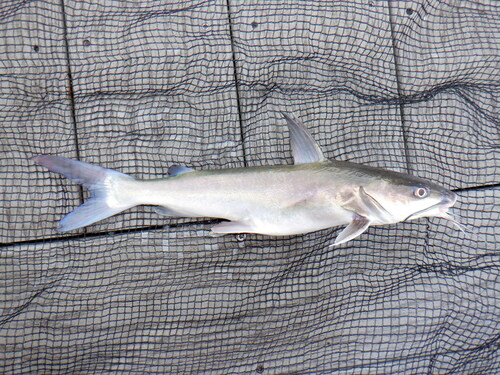
Hardhead Catfish
The Bluefin Tuna (Thunnus) is a group of highly migratory, large pelagic fish known for their incredible speed, size, and commercial value. They are apex predators in the marine ecosystem.
4 8 years
Lifespan
25 - 50 cm
Length
Least Concern
Conservation Status
15 km/h
Swimming speed
Detritivorous, Omnivorous
Diet
Local Migration
Migration
Appearance Overview
The Bluefin Tuna is renowned for its large, streamlined body, built for speed and endurance in the open ocean.
Color
Dark metallic blue on top with a silvery underside
Fins
Two dorsal fins, with the second being taller than the first
Body Shape
Torpedo-shaped, facilitating swift movement through water
Finlets
Small finlets running from the dorsal and anal fins to the tail
Length
Up to 13 feet (4 meters), commonly 6.5 feet (2 meters)
Weight
Up to 2,000 lbs (907 kg), commonly around 550 lbs (250 kg)
Diet
Carnivorous, feeding on fish, squid, crustaceans, and occasionally on plankton and other small organisms.
Feeding Behavior
Highly active predator, uses its speed to chase down prey. Bluefin tuna often hunt in schools, coordinating their movements to herd and capture prey efficiently.
Social Behavior
Highly migratory, forming large schools, especially during feeding and spawning. These schools can mix with other tuna species.
Commercial Relevance
Extremely high value in sushi and sashimi markets, particularly in Japan. The fatty belly meat, known as 'toro,' is a delicacy.
Conservation measures
Fishing quotas, international agreements (ICCAT), marine protected areas, and efforts to reduce bycatch. Research and monitoring programs are ongoing.
Status
Varies by species: Atlantic Bluefin (Endangered), Pacific Bluefin (Vulnerable), Southern Bluefin (Critically Endangered).
Threats
Overfishing driven by high demand for sushi, climate change affecting prey distribution, and habitat degradation.
Habitat Distribution
Depth Range
0-1,000 meters (0-3,280 feet), though they are most commonly found in the upper few hundred meters.
Geographic Range
Atlantic Bluefin: Atlantic Ocean; Pacific Bluefin: Pacific Ocean; Southern Bluefin: Southern Hemisphere oceans.
Preferred Environment
Temperate and subtropical waters, open ocean, and coastal areas. They are highly migratory and can tolerate a wide range of temperatures.
Reproduction and Life Cycle
Breeding Habits
Spawns in warm waters, with major spawning grounds including the Mediterranean Sea and the Gulf of Mexico for Atlantic Bluefin. Spawning typically occurs during specific seasons.
Development Stages
Eggs hatch into larvae, which develop rapidly in plankton-rich waters. Juveniles grow quickly, reaching significant size within their first few years.
Fecundity
Females can produce a large number of eggs per season, up to 30 million eggs, depending on their size and condition.
Maturity Age
Varies by species, generally matures between 4-8 years. Some populations may mature later.
Faqs about Hardhead Catfish
How fast can Bluefin Tuna swim?
Bluefin tuna are among the fastest fish in the ocean, capable of reaching speeds up to 43 mph (70 km/h) in short bursts.
What is the lifespan of a Bluefin Tuna?
They can live up to 40 years, although this varies between species and populations.
Are Bluefin Tuna warm-blooded?
Yes, they are warm-blooded, which allows them to maintain a higher body temperature than the surrounding water, aiding in muscle efficiency and speed.
How far do Bluefin Tuna migrate?
Bluefin tuna are highly migratory and can travel thousands of miles across oceans during their lifetimes.
What is 'toro' in the context of Bluefin Tuna?
The 'toro' is the fatty belly part of the tuna, prized for its rich flavor and melt-in-your-mouth texture.
Are there different species of Bluefin Tuna?
Yes, there are three main species: Atlantic, Pacific, and Southern Bluefin Tuna.
What is the biggest threat to Bluefin Tuna populations?
Overfishing is the primary threat, driven by the high demand for Bluefin tuna in the sushi market.
Where do Bluefin Tuna spawn?
They spawn in specific areas, with Atlantic Bluefin having two main spawning grounds: the Mediterranean Sea and the Gulf of Mexico.
Do Bluefin Tuna have any natural predators?
They are apex predators, but young tuna can be preyed upon by larger fish, sharks, and marine mammals.
Copyright @ Nature Style Limited. All Rights Reserved.
 English
English